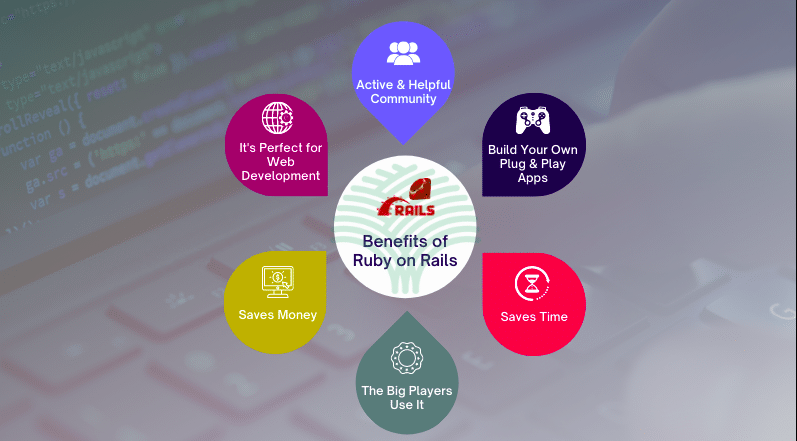
Top 10 Tips to Boost Ruby on Rails Performance
We all know that Ruby on Rails is excellent for developing web applications. The framework powers some of the most powerful web applications, including Shopify, Basecamp, GitHub, and even twitter. RoR Developers say that it is one of the easiest frameworks to work with. Project managers agree that Ruby on Rails reduces their costs and time by a factor of nearly 20-40%.
But even the best frameworks face lag. Ruby on Rails web development is far from perfect – but it delivers results. Companies agree to its efficiency. However, developers may face several issues in the framework. These can be due to human inefficiencies or internal glitches. In this article, we share 10 tips to boost the performance of your development process with Ruby on Rails.
Why choose Ruby on Rails in the first place?

Understanding the framework is the first to identify how to improve Ruby on Rails performance. It is the choice of web development platform for companies all across the globe. AirBnb, Basecamp, Shopify, GitHub, and several other MNCs use Ruby on Rails for web development. The latest version, Rails 6, is highly popular amongst developers and companies for developing interactive web apps.
However, Rails performance may also take the development experience downhill if the environment is not properly set up. But since Ruby on Rails is such an extensible and simplistic framework, it offers solutions for that as well. Rails 7 is a Rails 6 performance improvement, feature addition, and much richer version of the framework. Ruby on Rails is the perfect technology for enterprise and companies that want rapid app development.
Read Also: Common Mistakes to Avoid When Working with Rails Migrations
Why there is Need to Optimize Ruby on Rails Application?
Ruby on Rails is used extensively by companies of all sizes. The improvement of a Ruby on Rails app depends highly upon the performance of the framework. When Ruby on Rails optimization takes place, there can be better coding and much higher quality of applications. Since the performance of a web application depends upon the performance of its framework, it is important that Ruby on Rails doesn’t face any lag during the development process.
If you are using Rails 6, the first performance improvement is to upgrade the version to Rails 7. Even though you can do Rails 6 performance improvements, it would not be as good as the next version. Since Rails 6 would be more secure and better loaded with features, it makes sense to migrate your Ruby version for improving the overall performance of your web application.
Read more: Top Reasons Why Businesses Should Invest in Ruby on Rails Development
Tips to Optimize the Performance of a Ruby on Rails App
Here are the ten significant tips that can drive the performance of your Ruby on Rails app development process:
- Pareto for Ruby on Rails
Ruby on Rails can be difficult if you are trying to focus on everything. Micro-optimization never works. Follow the Pareto principle and focus on fixing the bigger issues that require attention. Probably eliminating database query time by a millisecond is not as important as other tasks. - Use the latest Ruby on Rails version
Rails 6.0 is here, and it only makes things simpler for the development team. It has parallel testing built in it, which can drastically reduce the final output delivery time. - Utilize server metrics
Understanding how much server load the Ruby on Rails development process is taking is a good way to optimize performance. You can use Telegraf to collect metrics, and Grafana to send warnings of something goes wrong. - Compress Active Record
Developers love ActiveRecord, but if you have massive amounts of data, avoid using it to insert the data. Instead, ActiveRecord-importgem is a much better way to insert this data. - Find faster
Optimize your Ruby on Rails web development process by using ActiveRecord#find_each to load the batch of data. It doesn’t make sense to use “all” and load all the data into memory at once. - Reduce JS bundle size
Using all the JavaScrip in your application.js will massively slow down the website speed. You may say 150ms, but the page will still load slow. Use Bundlephobia to determine the size of each npm and solve this problem. - Work with a different cache store
The default cache store for Ruby on Rails web development is slow for production use. Memcache or Redis are two stores that help you share cache between different processes and optimize development. - Turbolinks help
RoR Developers might get afraid of the multiple bindings of events like in JQuery spaghetti. Stimulus or React on Rails can help you better handle the JavaScript query and boost performance. - Utilize CDN
Fingerprinting in Ruby on Rails development enables better caching of JavaScrip, CSS, and Images. Cloudflare is an excellent CDN to quickly load these assets. - Materialized views for the database
The materialized view saves every result of the query. It is a faster process and can optimize development. By using it rightly, it can work wonders.
Multiply Your Application’s Performance With Ruby on Rails
In this article, we began by learning why companies should choose Ruby on Rails for web application development. It is affordable, extensible, scalable, and offers rapid prototyping capabilities. After that, we looked at why the performance of the Ruby on Rails framework matters. The framework’s performance impacts the performance of a web application – therefore, Ruby on Rails needs to perform smoothly.
Finally, we identified 10 things that could improve the performance of the framework. These tips will also lead to the performance improvement of the web application.
By following the above tips, any developer can multiply the performance of their processes. If you’re looking to build a web application that performs better, we can help. BoTree Technologies is a leading Ruby on Rails web development company that builds top-notch web applications for companies all over the world.
Consulting is free – let us help you grow!




